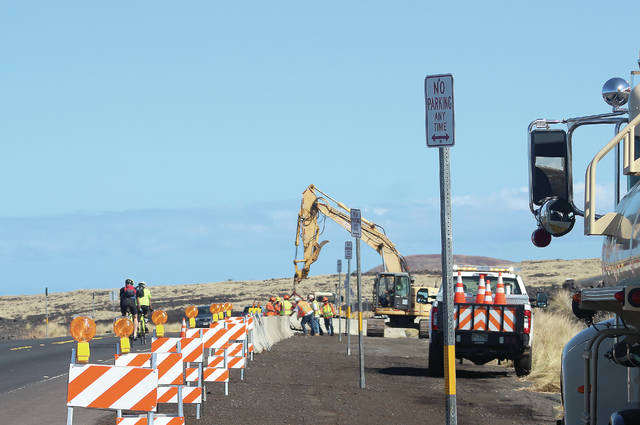KAILUA-KONA — A long-term solution for access to the Huehue lava tube is being looked at by the state Department of Transportation.
No parking signs and concrete barriers are being installed at the popular site located off Queen Kaahumanu Highway, about 2 miles north of Ellison Onizuka Kona International Airport at Keahole, to address safety concerns while the state determines how to go forward with recreation at the site. A no trespassing sign is also positioned at the entrance to the lava tube, said DOT spokeswoman Kelly Kunishige.
“Our next step will be to determine the liability issues associated with owning a property that is being used for recreational purposes,” she said, “and to work with other departments who would be better suited to manage and maintain a property like this going forward.”
She did not divulge additional details, including whether the state is considering creating a site where people can stop to look, such as a scenic lookout like is located near Kiholo Bay that provides safe ingress and egress from the popular viewing site. A timeline was also not given.
Ken Obenski, chairman of the Kona Traffic Safety Committee, chairman of the Hawaii County Traffic Safety Council and a member of the Governor’s Highway Safety Council, said the barriers won’t stop people from visiting the site. Instead, he said, people will likely park on the makai side of the highway and jaywalk across the 55-mph zone, or park before or after the barriers on the mauka side of the highway and walk, to the lava tube.
“It’s not going to stop people from going to the lava tube, it’s just forcing them to park in a more dangerous location,” said Obenski, who also writes a column for West Hawaii Today.
Separating the through traffic from those who want to take a look and creating a parking lot is the most feasible solution, he said, adding he recommended the concept of a “simulated island” to the state months ago. He said the National Park Service uses it frequently at sites that become popular for stopping. The county also has something similar in place with the scenic outlook on Kamehameha III Road.
“It’s hard to stop people from being people — they are going to do what they want to do as long as they don’t see the harm they are going to ignore everything you do,” said Obenski. “But, if you make it easy to do the safe thing, then the majority of the people will do the right thing if you let them.”
Others expressed similar sentiment to Obenski in letters to the editor and on social media, asking the state to make the area safe to visit.
“The county depends on the tourist economy for a large part of its budget and salary. Reducing visitor attractions is not in the interest of the County of Hawaii or the State of Hawaii. Make it safe, do not eliminate it,” wrote Kailua-Kona resident Donna Goodale.
The lava tube, created during the 1801 Huehue flow from Hualalai’s northwest flank, attracts visitors and residents alike curious as to what is within. Promotion for the lava tube is easily found online and in travel books, and it’s more than visible from the roadway. Its popularity also seemingly increased amid the ongoing closure of Nahuku or Thurston Lava Tube within Hawaii Volcanoes National Park.
Depending on the time of day, the number of vehicles at the site reached several dozen. In some instances, food vendors, buses and tour vans have been spotted at the site.
The state began installing no parking signs on Jan. 7 and work to place 1,000 feet of concrete barrier continues. The move follows an August 2018 article published by West Hawaii Today highlighting safety concerns at the popular site near mile marker 91.
During the work, lane closures may be required.
Work did not take place on Monday because of the Martin Luther King Jr. holiday, but was planned Tuesday through Friday from 8 a.m. to 2 p.m.






